AC Milan were held to a 1-1 draw by Atalanta at San Siro, after an early Rafael Leao goal was cancelled out by a dubious VAR penalty award.
The result keeps the two clubs seven points apart in Serie A but allowed Juventus to extend their lead in second place to four points.
Stefano Pioli believed his side “deserved the victory” and Gian Piero Gasperini seemingly agreed, admitting his team earned “a very difficult point”. Here to provide his tactical observations on the game is @Tactics_Tweets.
Milan’s dominance
The statistics certainly supported both manager’s assessments that Milan were the more deserving winners of this match. The Rossoneri had 70% possession, out shot their opponents 19-8 – including only conceding one attempt on goal in the second half, had 74% field tilt – ball possession % calculated for touches completed only in final thirds – and when you strip out the (harshly awarded) Atalanta penalty, generated a higher xG total too (1.66-0.85).
The home team not only outperformed the away side in the data metrics but they also affected their opponents usual style of play. This season in Serie A, Atalanta have averaged 48% possession of the ball so suffered a drop-off in their share in this fixture. But this was not the only metric Gasperini’s team fell short in when compared to their usual per 90 averages.
Against Milan, Atalanta made 268 passes compared to a usual average of 466, they had a lower PPDA of 13.86 compared to a 10.42 average and allowed more shots (19) on their goal than they typically do (11).
However, despite Milan’s dominance their only breakthrough came from an individual piece of brilliance by Leão in the 3rd minute. For the remainder of the game, the hosts were effective at controlling the game, with and without the ball, but suffered with a lack of penetration and accuracy in the final third.
Only 26% of their crosses and under half (42%) of their passes to the penalty area were completed and this meant that Milan’s superiority only ended up resulting in a high volume of shots as opposed to high quality ones.
And much of Milan’s success – and failure – against Atalanta can be attributed to the two team’s cancelling each other.
Pioli and Gasperini cancel each other out
Although Milan and Atalanta play different systems, in their most simplest descriptions a 4-2-3-1 and 3-4-1-2 respectively, one tactical tendency the two share is using a player-orientated approach when out of possession.
Here’s an example of the Milan pressing scheme in action within the opening five minutes. The three forwards each took one of the Atalanta back three, Ruben Loftus-Cheek and Ismaël Bennacer pushed up to the opposition double pivot (Marten de Roon and Éderson) and Yacine Adli picked up the more advanced Teun Koopmeiners. This left the Milan back four to cover four Atalanta players – their two wing-backs and two forwards (Charles De Ketelaere and Aleksei Miranchuk).

But in an attempt to maintain a +1 coverage in their backline, the hosts tucked in their far-side full-back infield (see Theo Hernández below) when their ball-side full-back (see Alessandro Florenzi above) jumped to engage the opposition wing-back when in possession.
Whilst this system resulted in a Milan weak-side e.g. Emil Holm free on the far-side of the pitch, it did allow for the hosts to create a situational 3v2 at the back once their full-back pushed ahead to support the press.
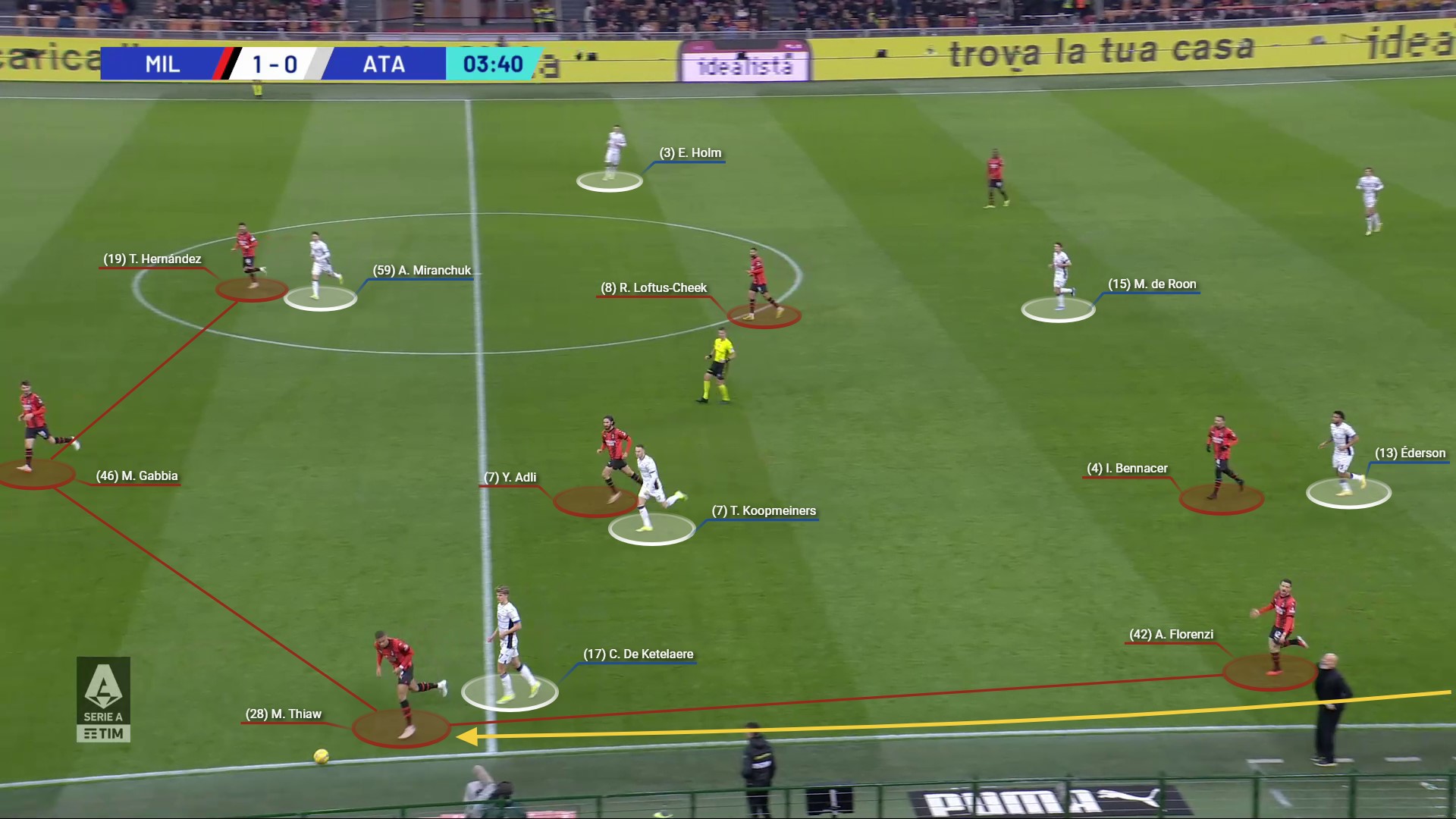
In the above passage, Milan’s pressure forced Atalanta into a rushed forward pass that ended up being intercepted by Malick Thiaw (but did result in winning a throw-in). And if we rewind the clock a minute prior, Milan’s pressing scheme also played its part in the lead up to Leão’s goal.
The sequence started with Milan initiating their player-to-player scheme and forcing their opponents out wide…
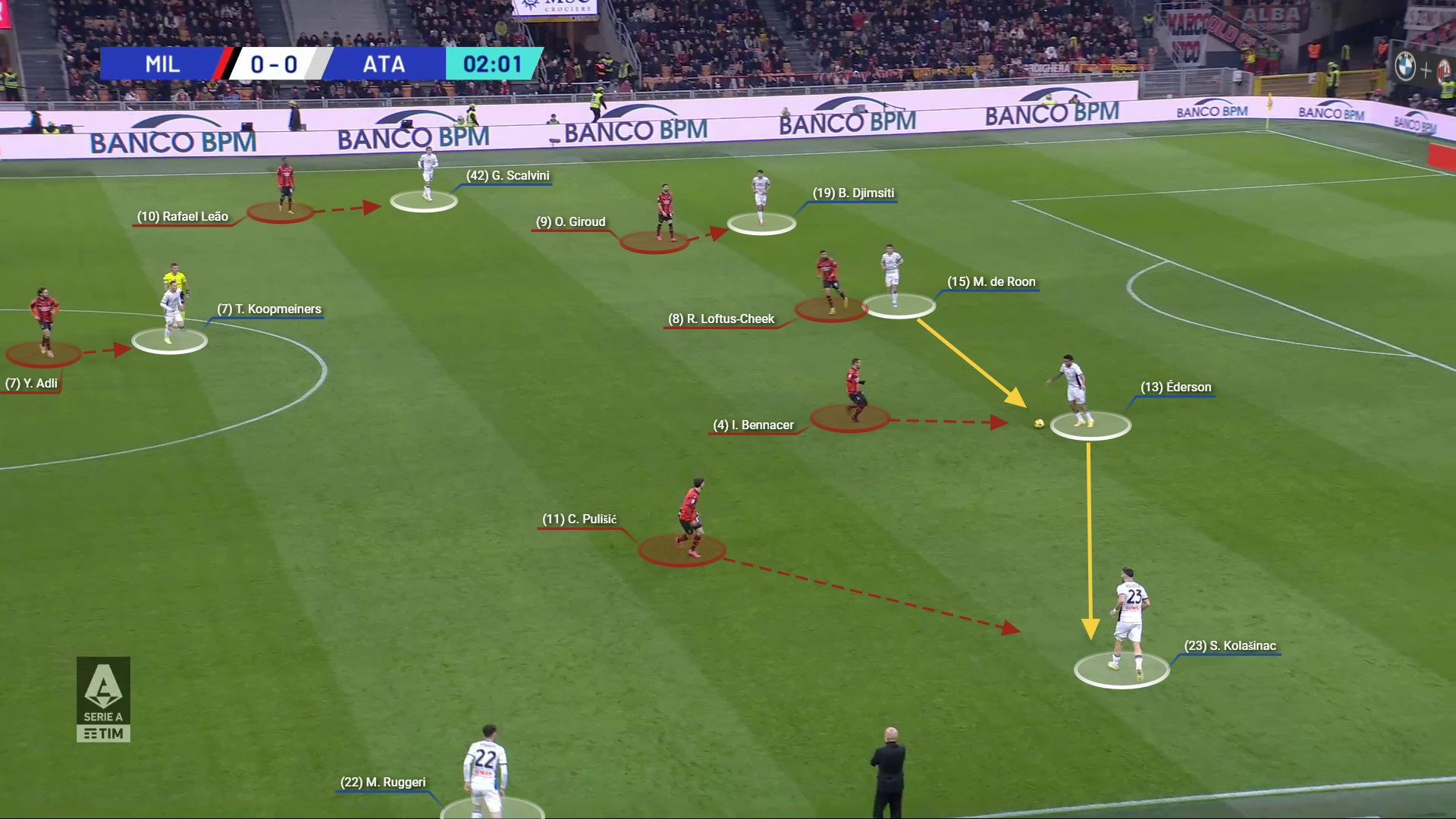
…where Sead Kolašinac and Matteo Ruggeri were not on the same page and ended up losing possession to Florenzi.
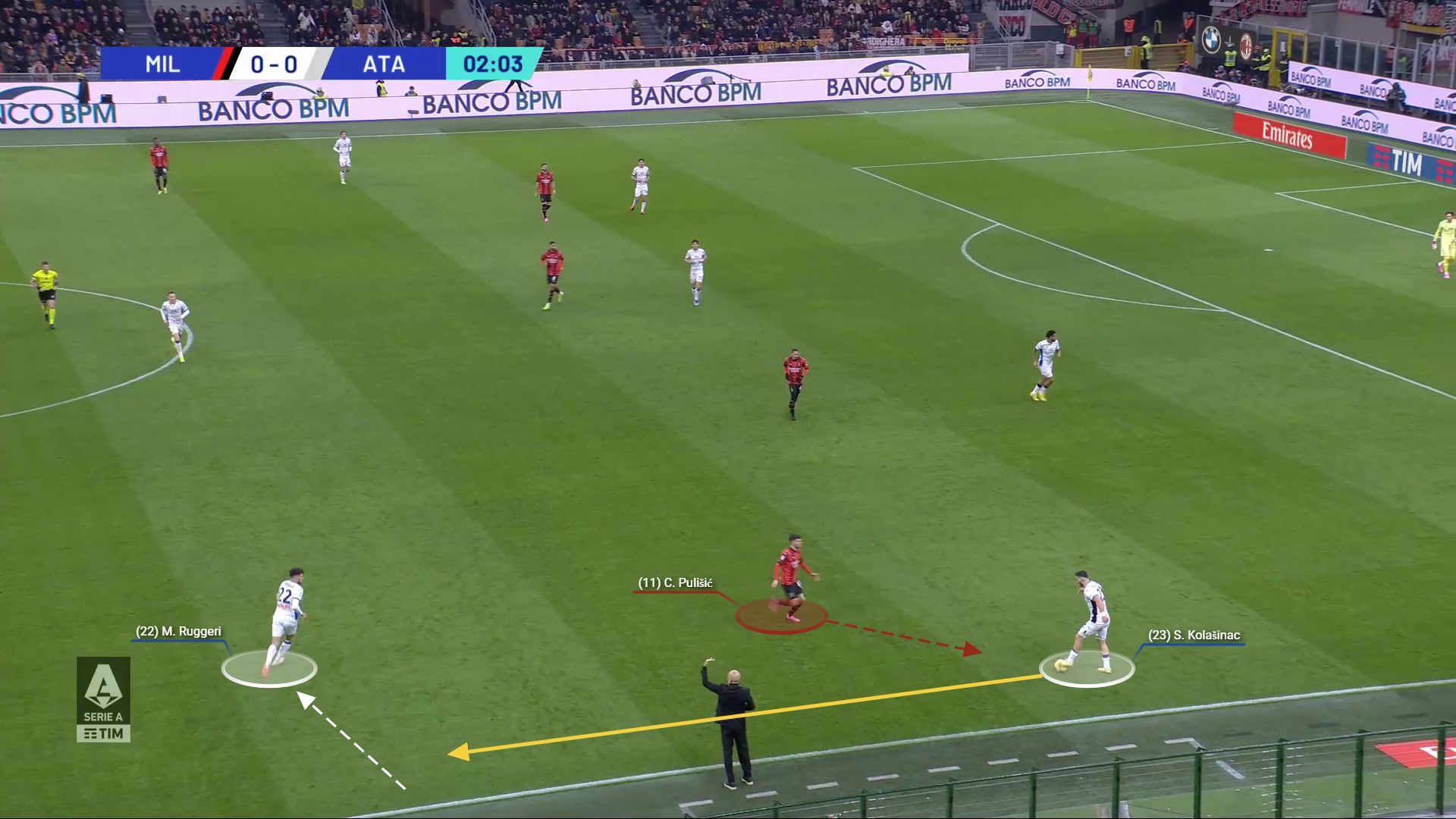

It was from here that Milan started the attack which twenty seconds later ended up with Leão’s spectacular strike into the top corner.
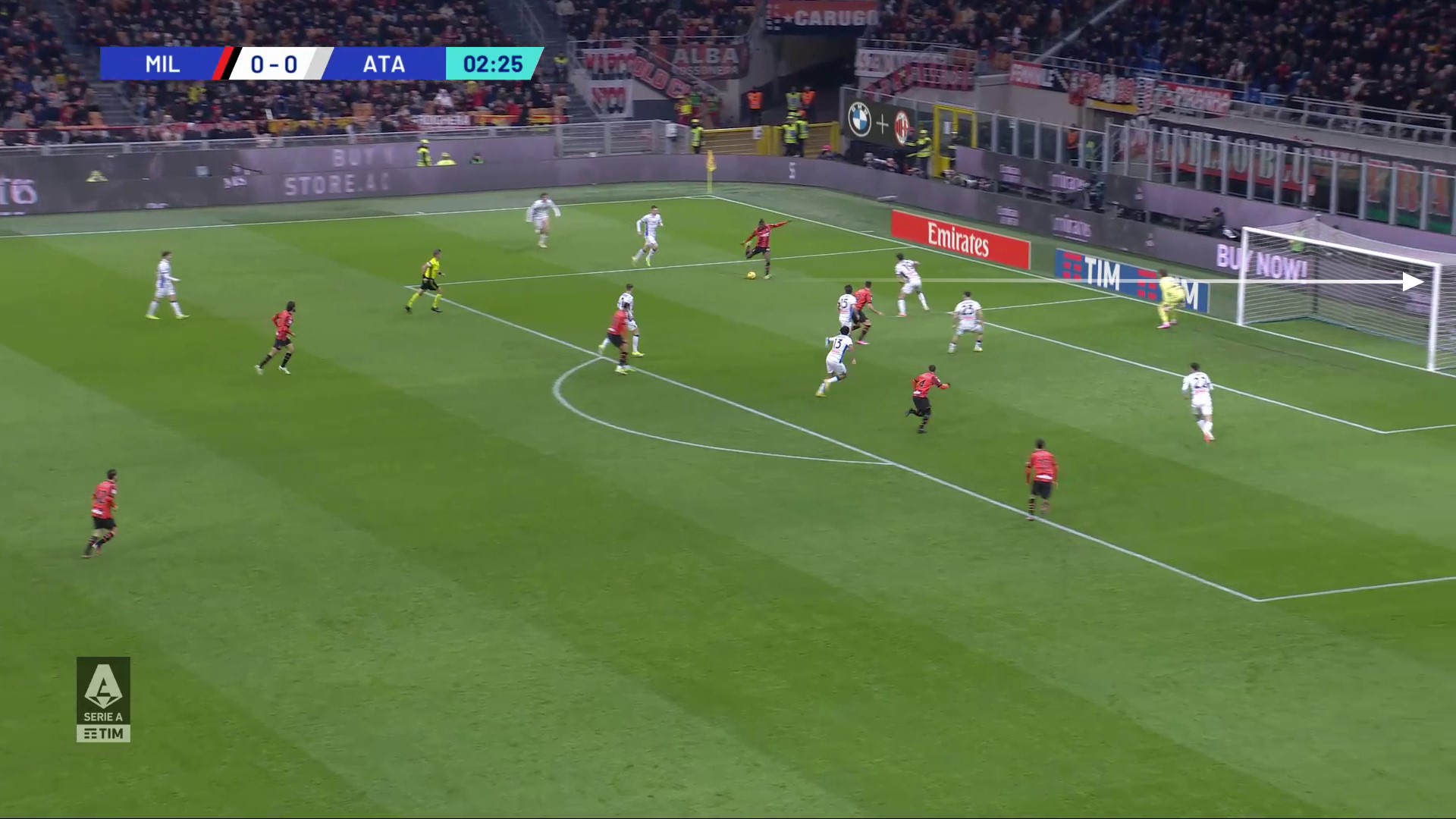
And Milan’s out of possession approach helped contribute to the hosts having over two thirds (73%) of the ball in the first half.
Whilst the visitors were also using player-oriented aspects without the ball, they were more passive during Milan build-up phases (evidenced by their lower than average PPDA) and therefore were less effective in disrupting their opponents possession phases – at least until play reached the final third.
Atalanta were also having to readjust to which players marked who in the opening forty five minutes, both in the regards to instructions from the bench and reacting to the dynamic situations that occurred on the pitch. Here’s an instance from the 14th minute which shows these difficulties in practice.
Milan had possession in their own half and the Atalanta players were passively engaging their direct opponents. The away team seemed to switch up whose responsibility it was to close down Florenzi when in possession with previous occurrences including Koopmeiners and Ruggeri but on this occasion the task fell to Éderson.
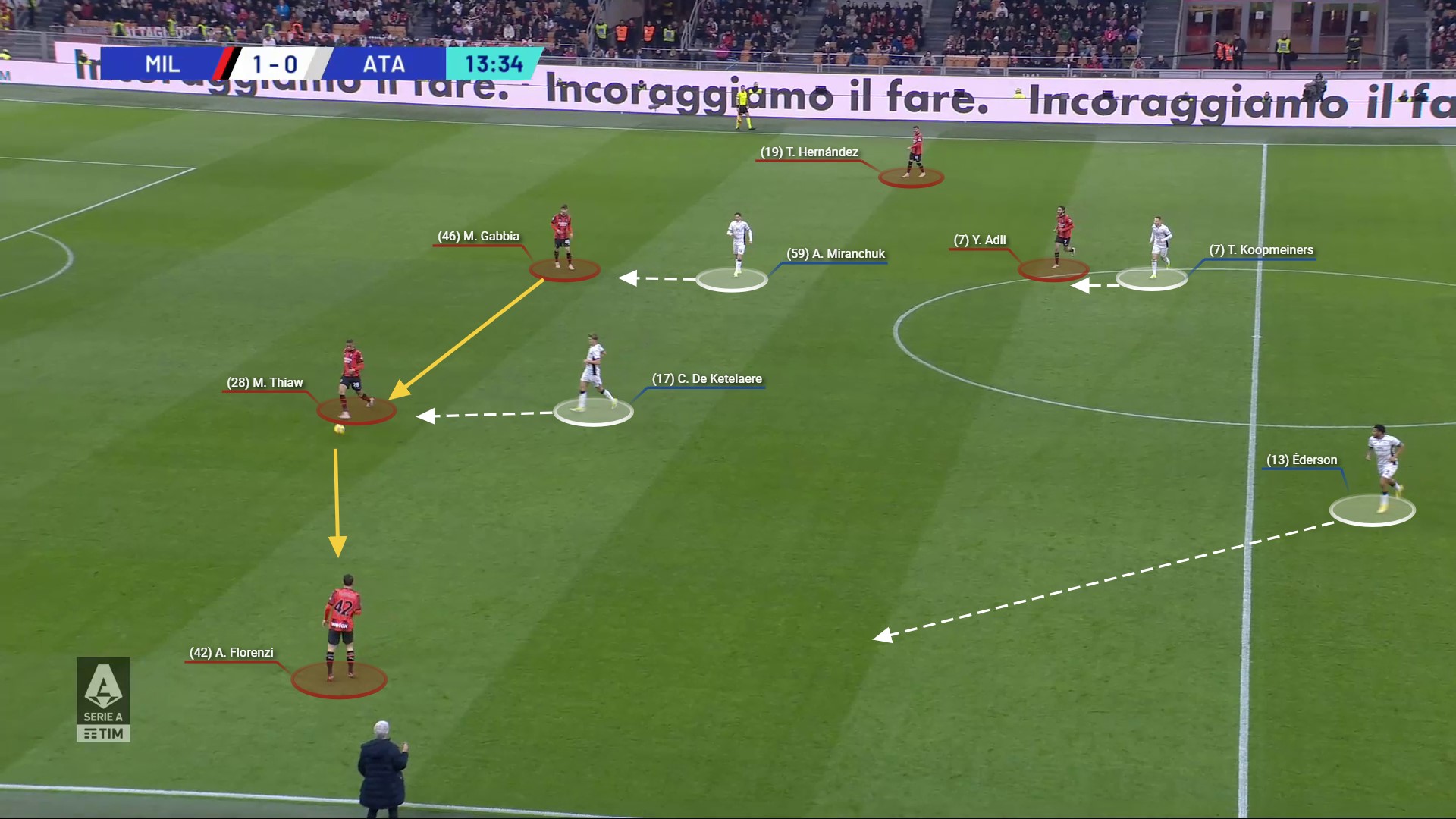
But the Atalanta central midfielder jumping caused a weakness to open up centrally and Giroud aimed to exploit this by showing short for the ball which Florenzi found.
Below you can also roughly see the responsibilities of the remaining Atalanta players – but importantly how players in advance of the ball began to drop back into the team’s defensive shape (5-2-1-2) once they had been bypassed.

Milan ended up recycling possession back towards Mike Maignan who was free, as no man-marker. The French goalkeeper was frequently used by the home side as their spare player in deep build-up and/or as a means of executing long forward passes.
In this action, Maignan was able to find an unmarked Loftus-Cheek with a line breaking pass.
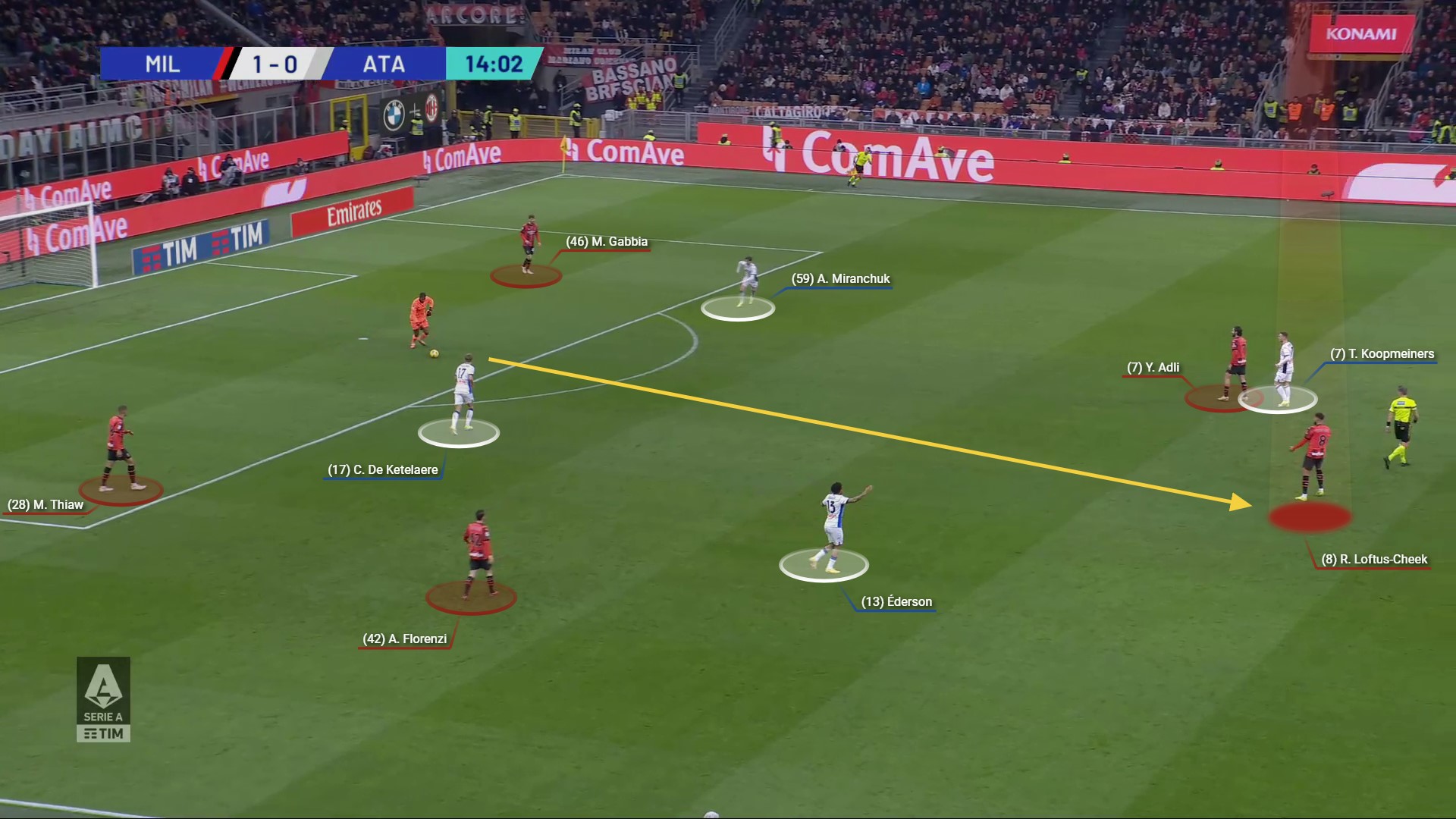
The English midfielder had dropped short, in between Éderson (who had been focussed on Florenzi) and de Roon (who had preemptively pushed up to cover Hernández) to create an overload and passing lane, with none of the Atalanta backline jumping up to follow either.

As a result, Loftus-Cheek was able to carry towards the final third where he passed to Leão out wide but in a perfect illustration of Milan’s lack of accuracy in this area of the pitch, the Portuguese attacker failed to find a teammate and the ball was easily cleared.

Across the ninety minutes, Leão attempted seven crosses – the highest in the team – but only found a teammate one time. However, it’s worth highlighting that Leão did perform well across other metrics, some notable ones including volume (13) and success of dribbles (77%), offensive duels won (63%), and progressive passing accuracy (8 out 9).
Here’s another example from the 32nd minute which showcases Milan’s effectiveness in reaching the final third but then failing to replicate their success in their final action. This passage of play began with Maignan again in possession. Adli and Bennacer had rotated to disrupt Atalanta’s marking scheme and this allowed the Algerian to exchange passess with his goalkeeper.

From here, Maignan passed to Thiaw who, after seeing a disjointed Atalanta defensive shape ahead of him, decided to go long towards the forward line.
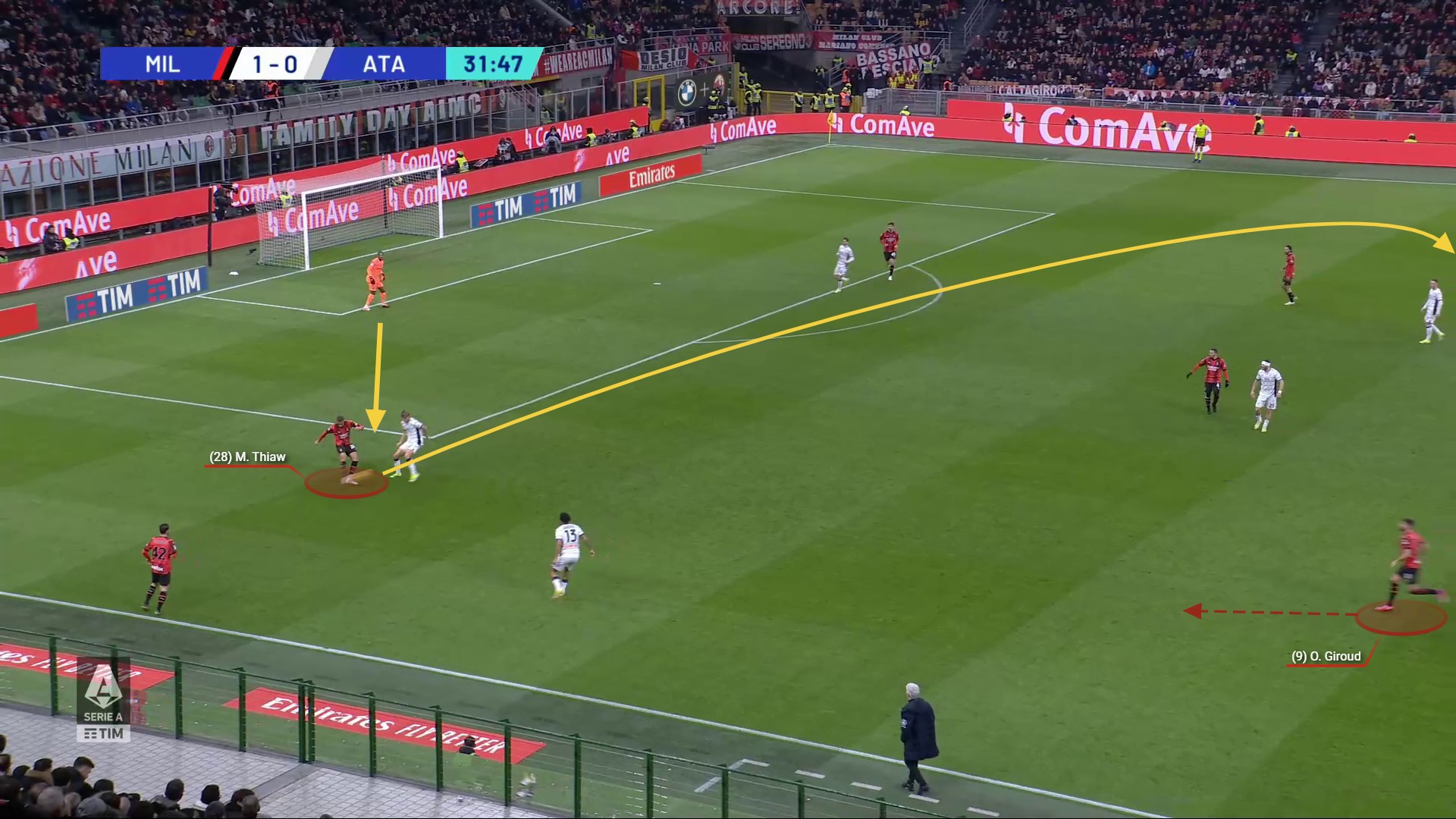
Thiaw’s pass bypassed six opposition players and after an infield Pulisic controlled the ball, he laid it off to Leão who then worked his magic to beat multiple Atalanta players and carry the ball forward where he exchanged passes with Hernández out wide…
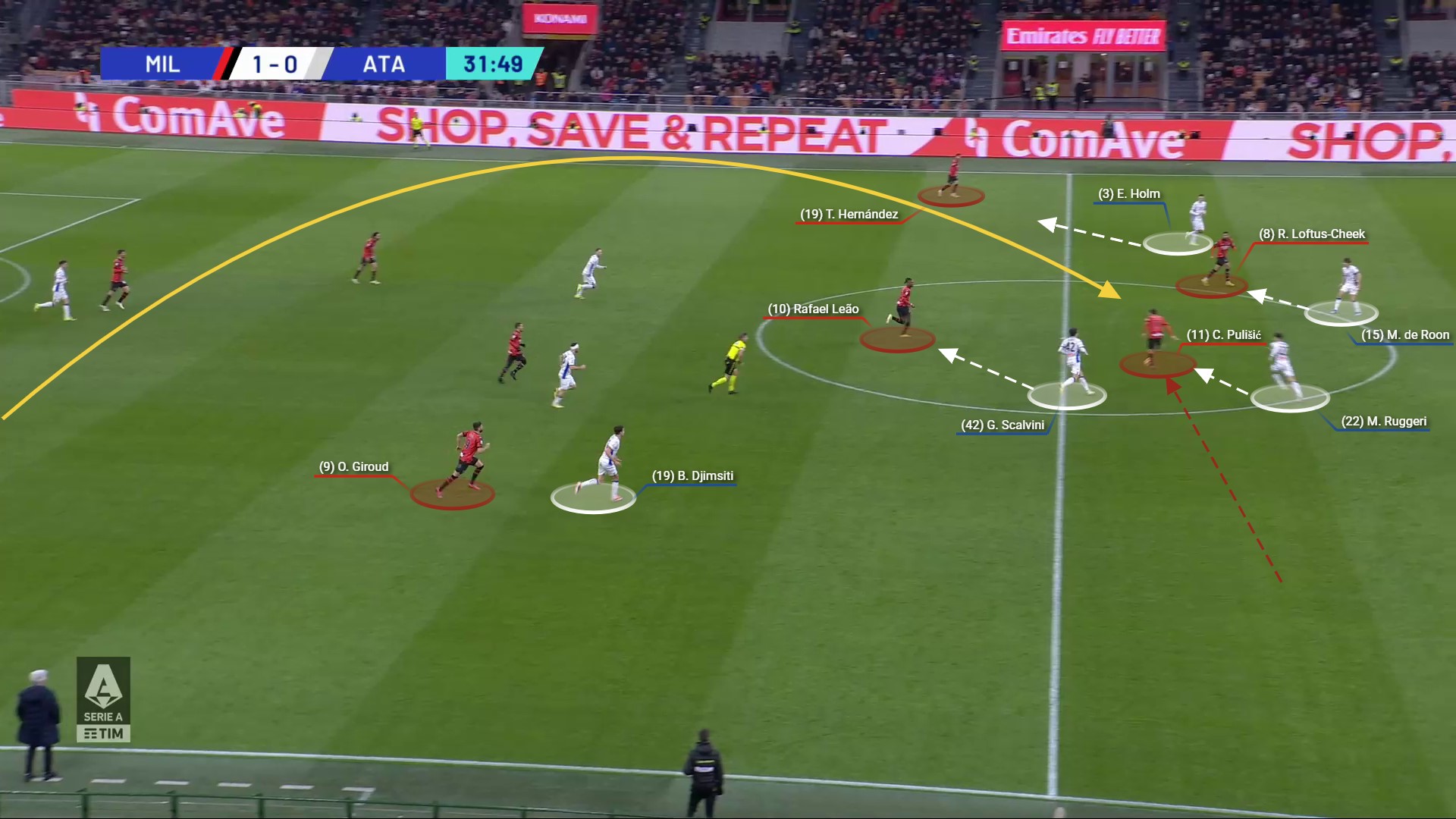
…before crossing towards the far post where Loftus-Cheek was 1v1. However, the ball ended up getting claimed by Marco Carnesecchi and the attack ended.

As mentioned, Milan very much controlled the game both with and without the ball and their out of possession scheme played a major contributing factor in their dominance. In total, Pioli’s side managed 82 recoveries against Atalanta – a recovery is classified as any action that ends a possession of the opposition team and starts a possession for your team – and this was their 3rd highest number of the season.
Below is another example of this in practice, with Atalanta attempting to play out via their right-hand side but with all nearby passing options covered…
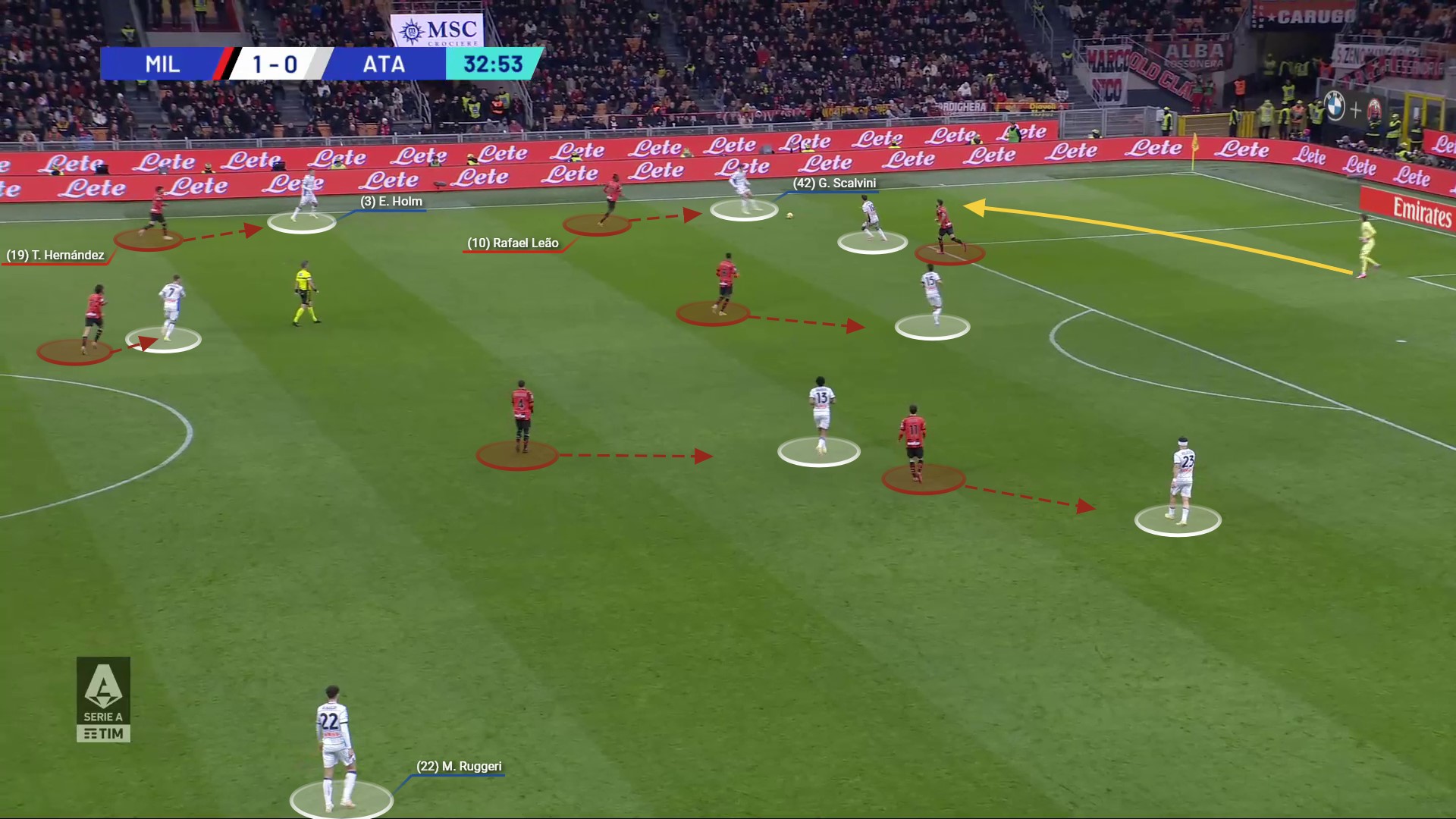
…the visitors worked the ball over to their left-hand side where Milan were quick to react. First, Loftus-Cheek immediately pushed up to engage de Roon, who had dropped into the backline, and this pressure denied any vertical passing options and instead forced play out wide.

From here Kolašinac attempted to execute a one-two combination with Ruggeri but Milan’s pressure and tracking of opponents helped them regain possession of the ball.


Overall, Milan should have been very pleased with their first half performance, across all phases of play. However, as we already know, VAR soured those memories but Milan were not completely without blame in the lead up to the Atalanta penalty award.
In the 38th minute, Milan were on the attack but ended up losing possession in the opposition penalty box which was reclaimed by Carnesecchi. The Atalanta goalkeeper, sensing an opportunity to counter with numerous Milan players high up the pitch, immediately threw the ball out to Holm on the right wing.
However, as you can see below, Milan were relatively comfortable in this situation with the ball being engaged, opponents being marked and numbers retreating.
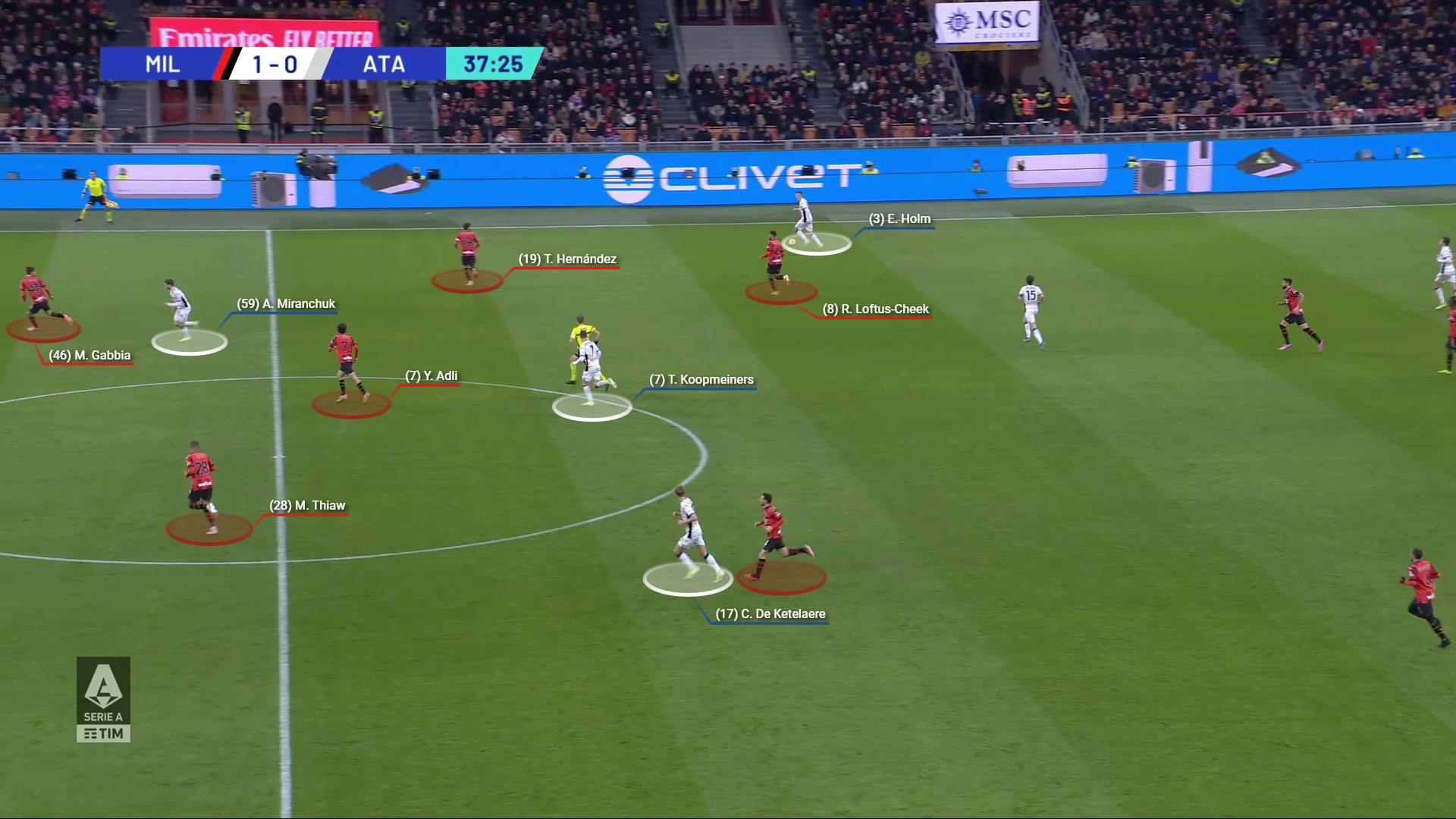
Koopmeiners made a channel run to offer Holm a forward passing option and this was tracked by Adli – again, no immediate danger here, with Milan having coverage behind the ball.

However, the problem arose when Holm stole a march on Hernández, after a momentary glance away, and this enabled the Atalanta right wing-back to get ahead of his opponent to receive the ball back from Koopmeiners.
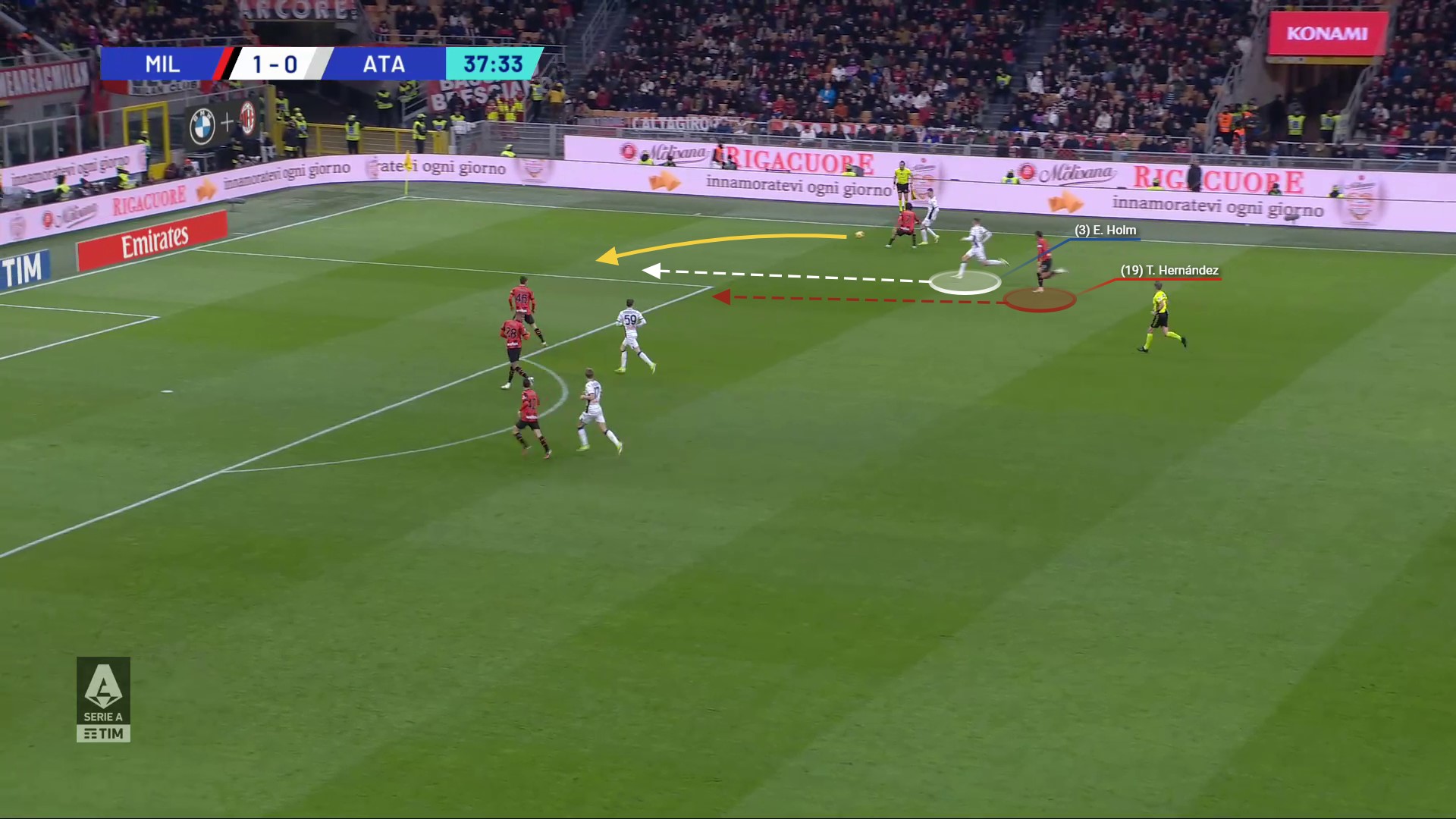
Hernández did well to recover, with his slide tackle winning the ball (but conceding the corner kick which led to the dubious penalty award). However, this minor detail cost Milan from going into the interval with a deserved lead – as quite frankly, Atalanta had not caused any genuine goal threat prior which warranted them being level.
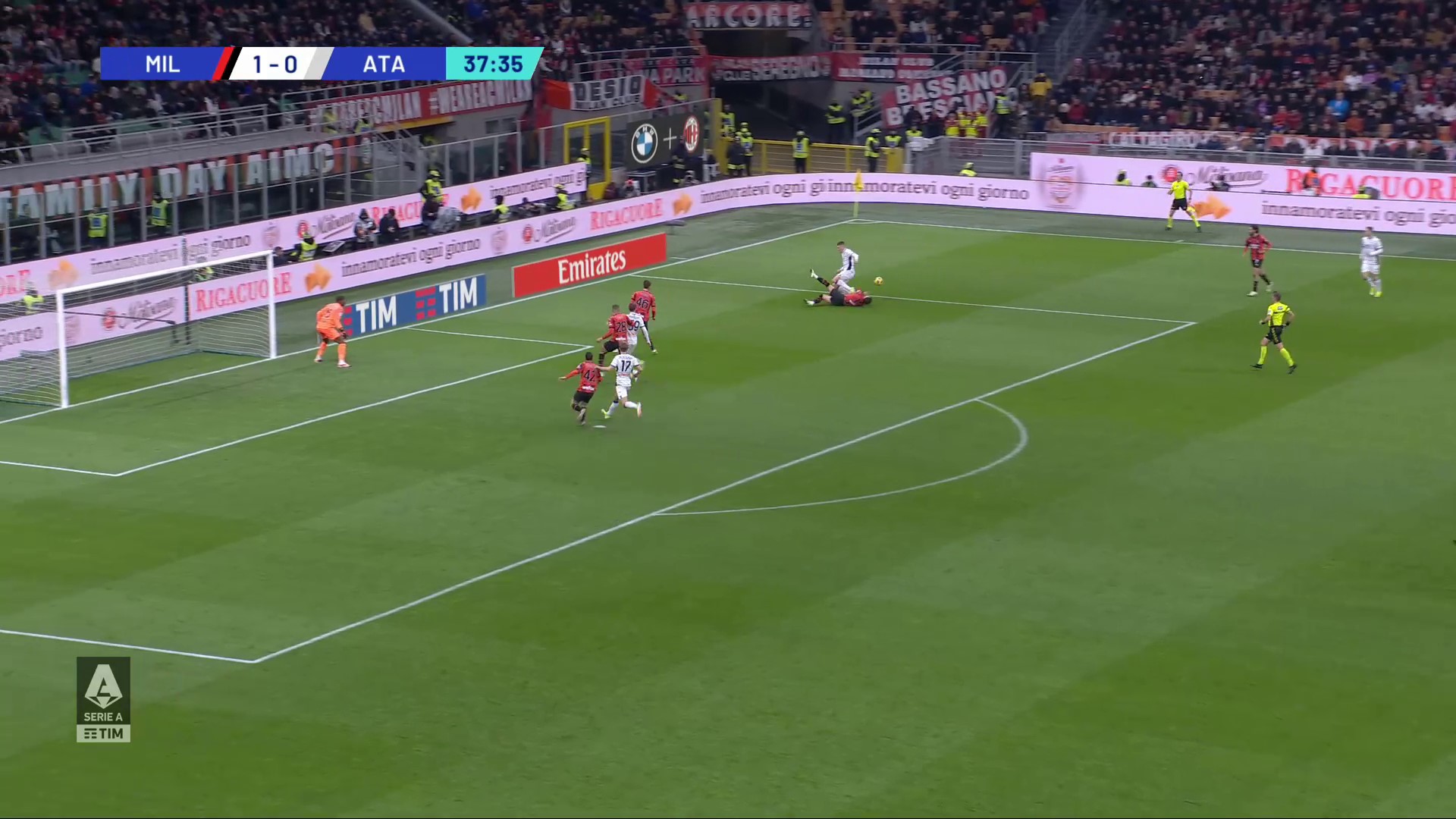
In the second half, the game continued in a similar vein. Although, in the first fifteen minutes after the break the game was a relatively uneventful affair. Milan were unambitious with the ball and Atalanta were content at sitting off without it. There were signs of encouragement in the 61st minute though when Milan worked the ball through the thirds and generated a shot on goal.
Play started with deep possession for the hosts. Here, Atalanta were prioritising their defensive shape, allowing the Milan full-backs to receive initially unopposed. Once they did, readjustments were made with Éderson going to engage substitute Davide Calabria and passing on Bennacer to Kolašinac.

The switch in marking responsibilities did however afford time for Milan to progress the ball forward. Firstly from Calabria to Bennacer, and then onto the still unmarked Hernández who only after receiving possession was tentatively closed down by Scalvini. With Leão now 1v1 with the opposition right wing-back…

…the attacker was able to find a pass into Giroud’s feet inside the area who then laid the ball back towards Bennacer.

It’s worth noting, in the visuals above, how Atalanta were effective in getting players back as possession progressed towards their defensive third. This retreating tendency is a clear principle of play and in instances like this one – where Calabria was found inside the box – shooting opportunities were made difficult with the amount of bodies that needed to be beaten.
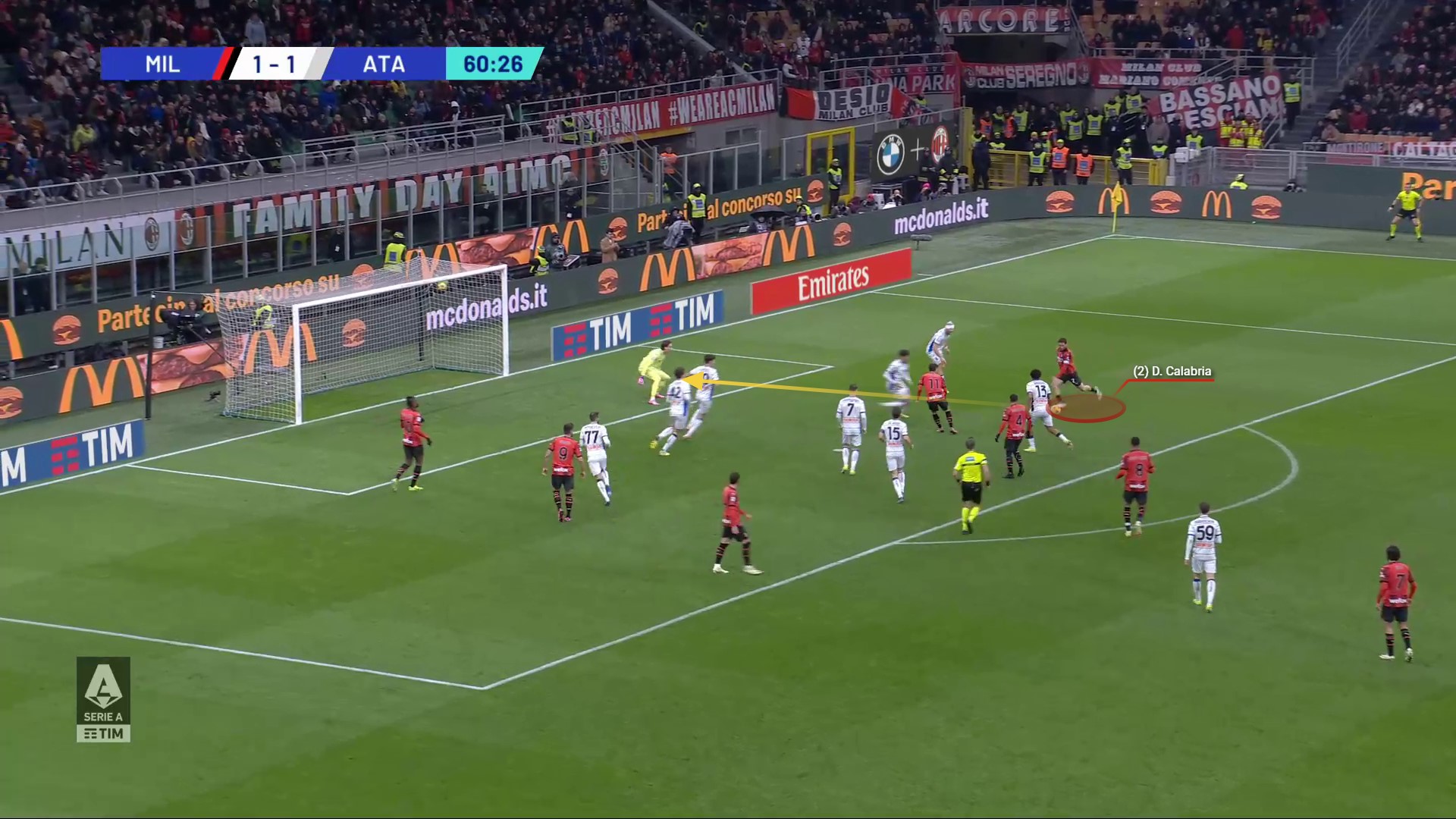
And in truth, both side’s effectiveness during defensive phases, using different systems but using similar tactics, was the root cause of why each side ended up cancelling the other out in this match.
After the half-time break, the visitors resorted to – or were forced into depending on your outlook – going longer with their passes (14% long pass share in the second half compared to only 7% in the first). And this factor played a part in why Atalanta only managed one shot on goal in the second half.
Here’s a demonstration of this in action. In the 70th minute, Atalanta were actually on the attack but an overhit cross from the left wing ended up with the right wing-back, who decided to recycle possession.
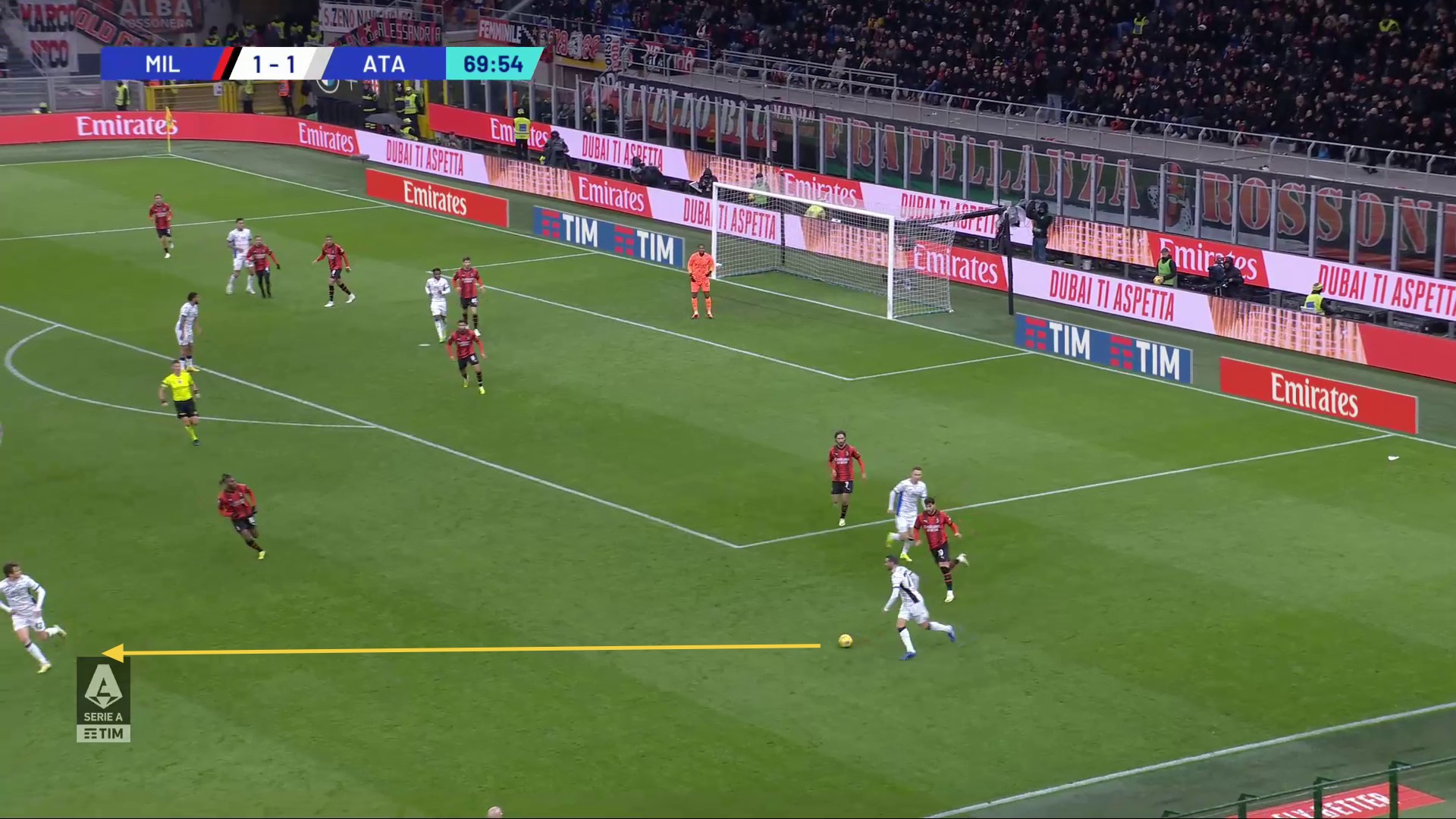
But this backwards pass was a trigger for Milan to initiate their player-orientated pressing scheme.
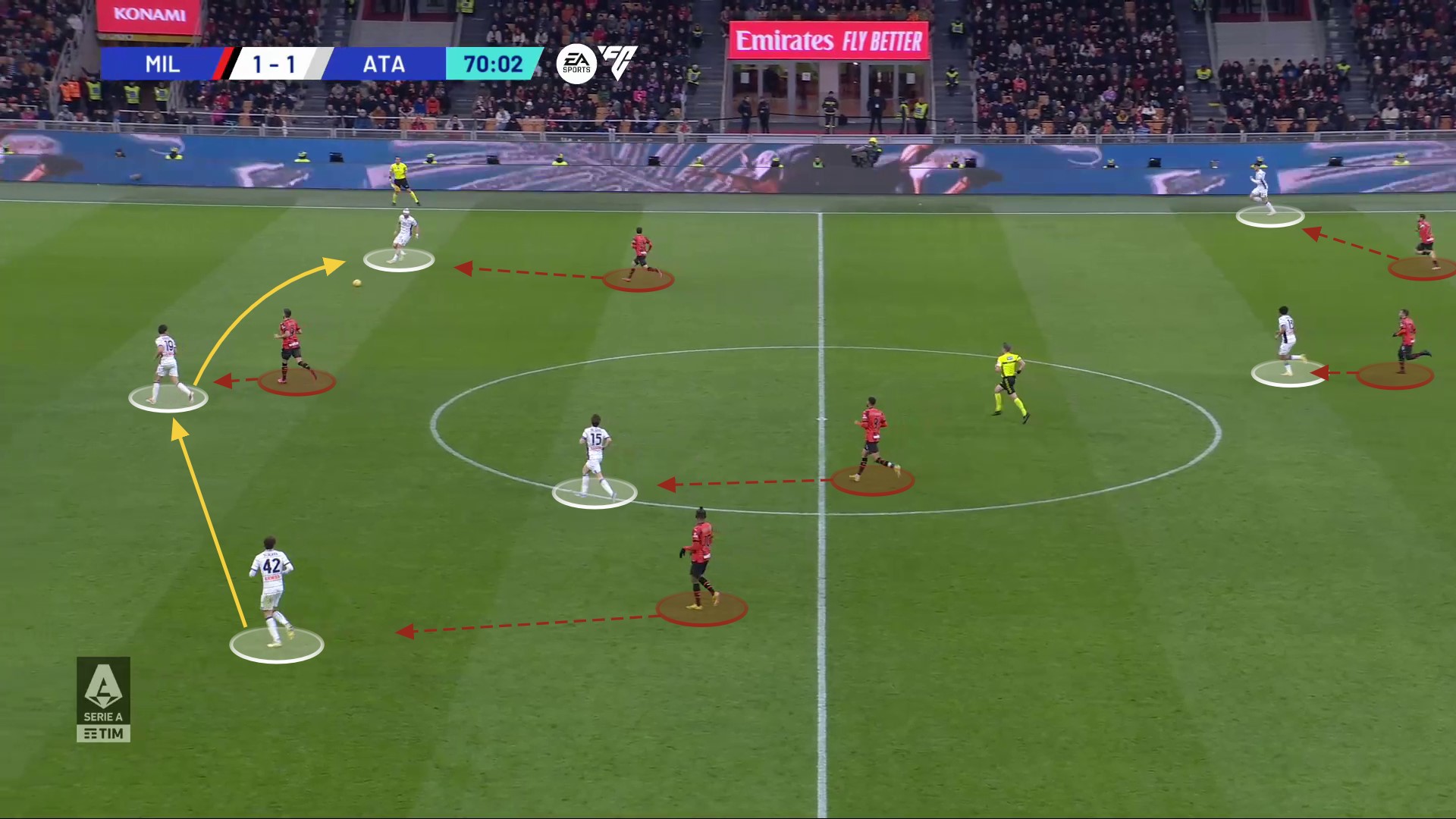
Atalanta managed to work the ball back over to their left-flank but under immediate pressure from Calabria, Ruggeri decided to play a hopeful, and blind, long pass towards his forward line which the Milan back line easily collected to regain possession.
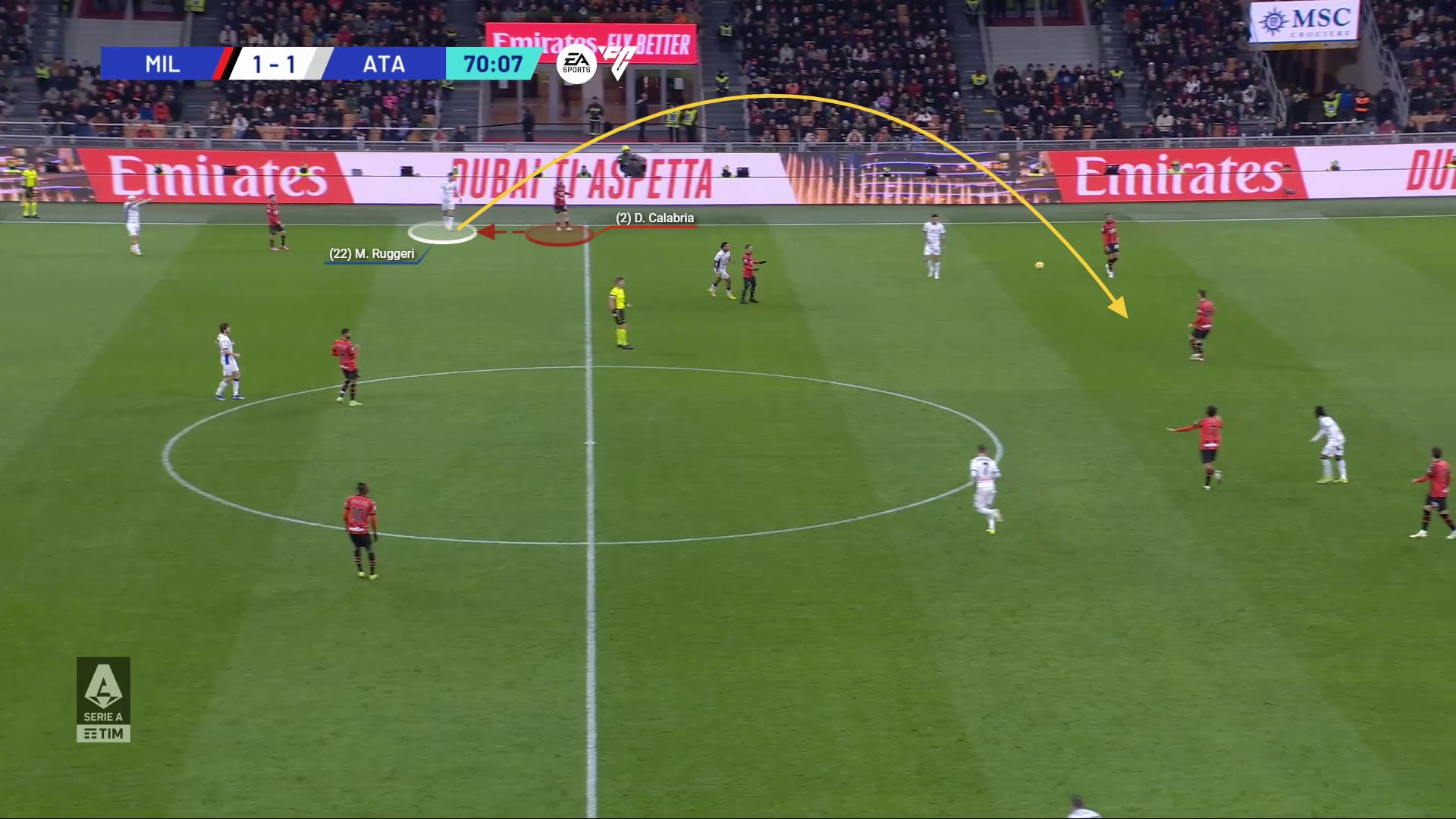
But despite Milan’s superiority, they only managed to secure one point from this fixture. Or as Gasperini described it from an Atalanta perspective: “…with our teeth we took away this point.”
Up next
The sentiment of the Milan team post-match seemed one of pride in their performance. Alessandro Florenzi stated that his side “missed the final spark, but we really played a great game”.
On Friday evening, Milan travel to Rome to face Lazio where according to Florenzi, ‘if we play like this every match then our opponents will rarely get the better of us’. The proof will be in the pudding.

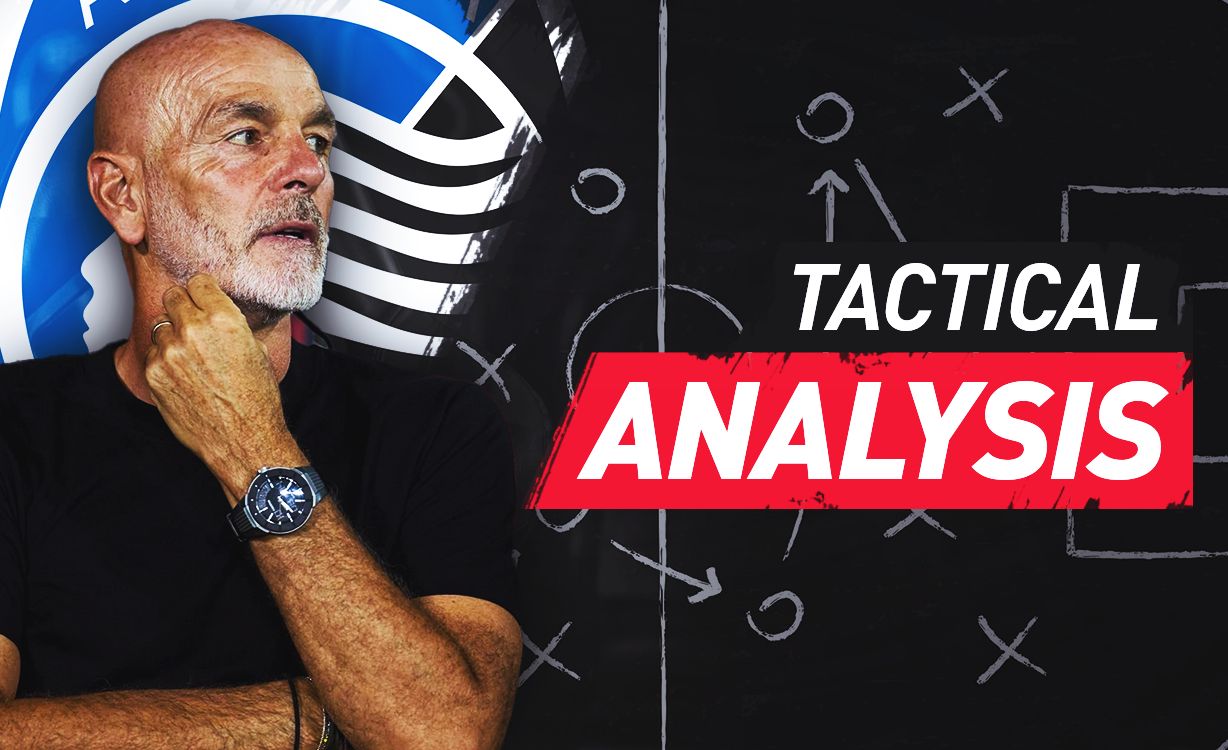
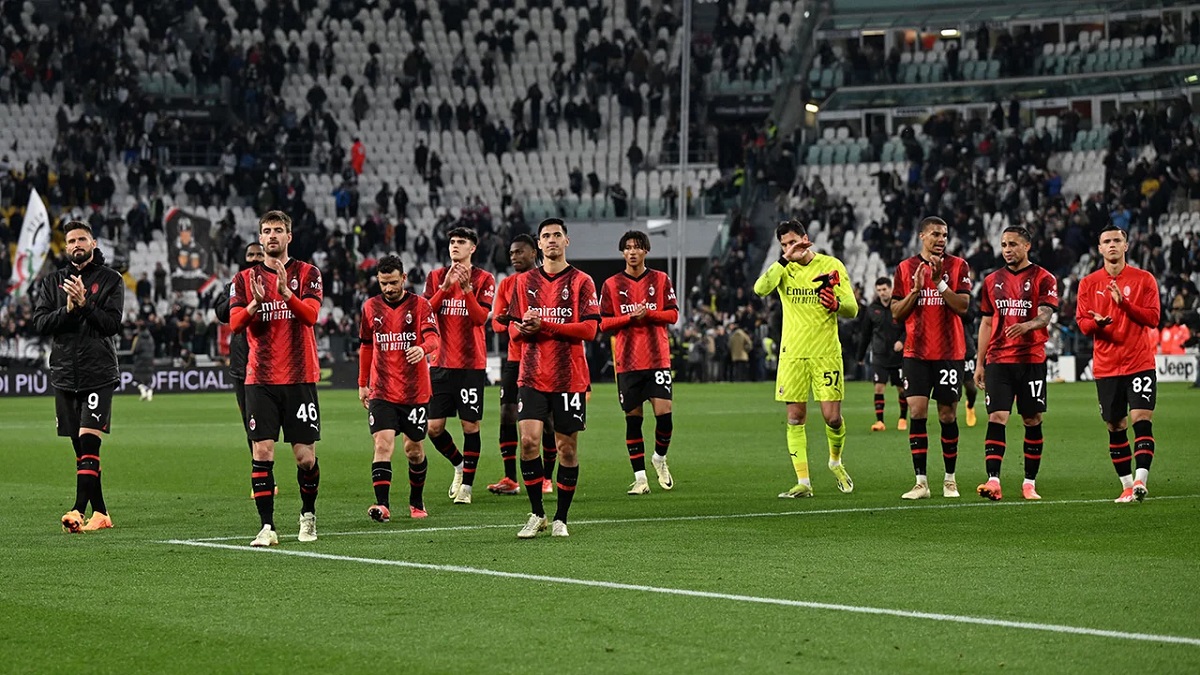

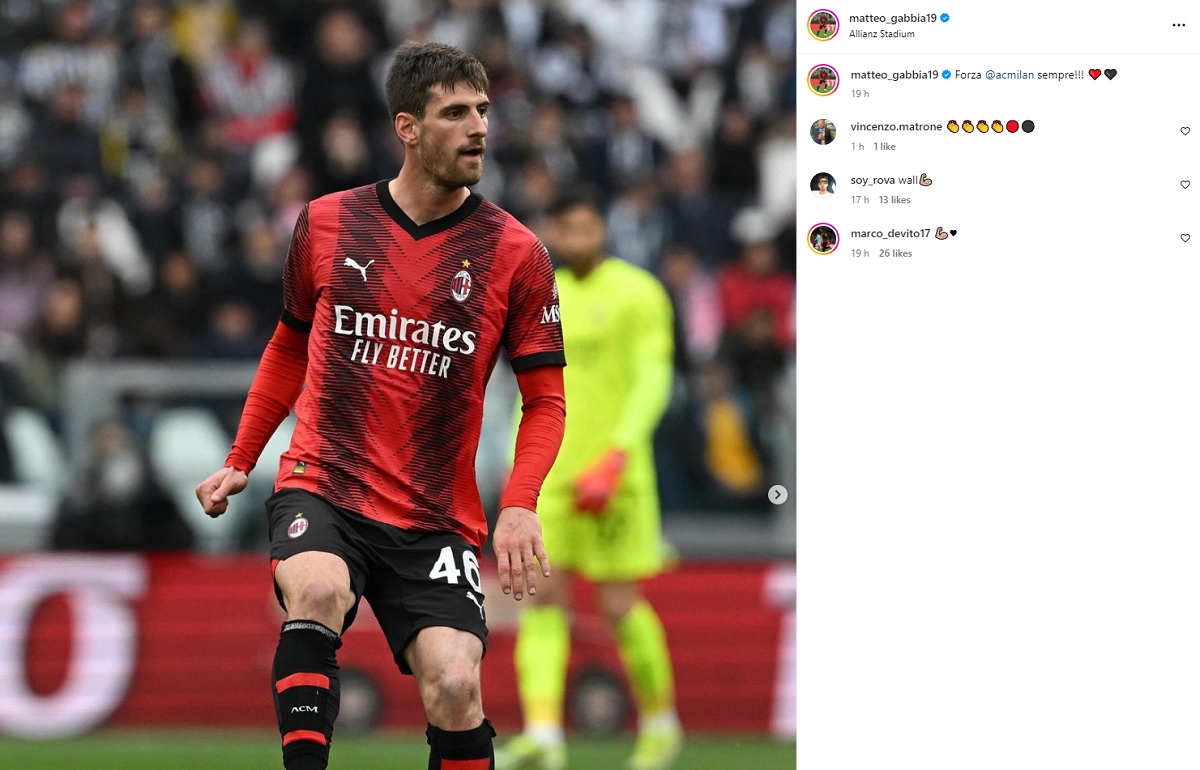
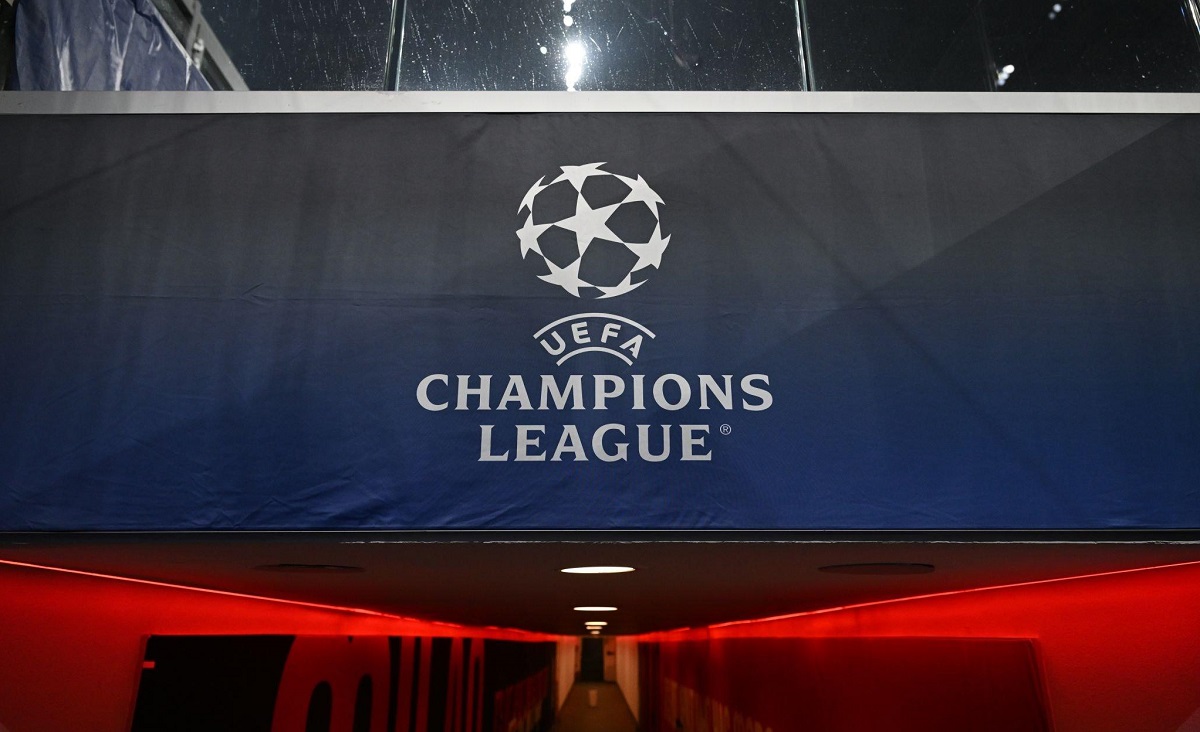

Gasperini did jack sh*t, if it wasnt for the ref this would’ve been a loss for them, they were never even close to scoring